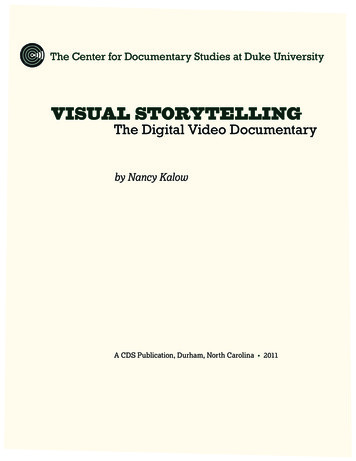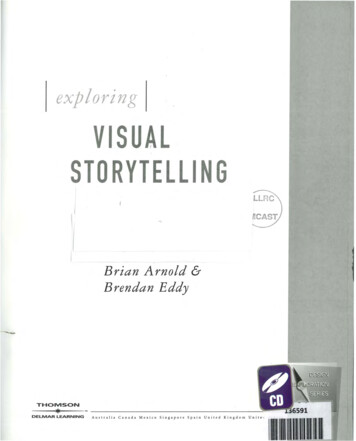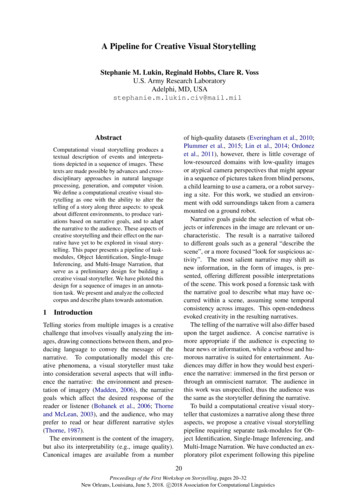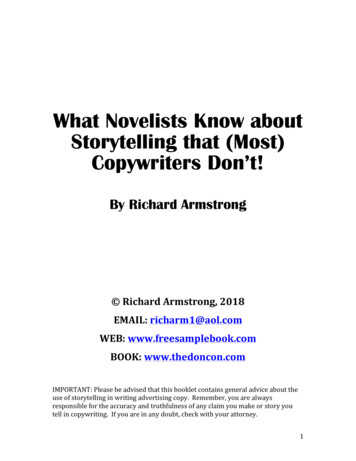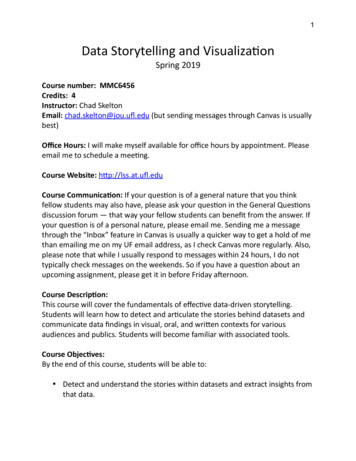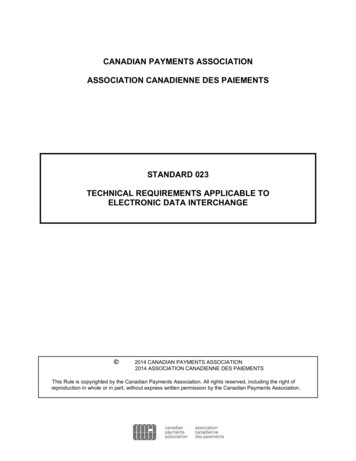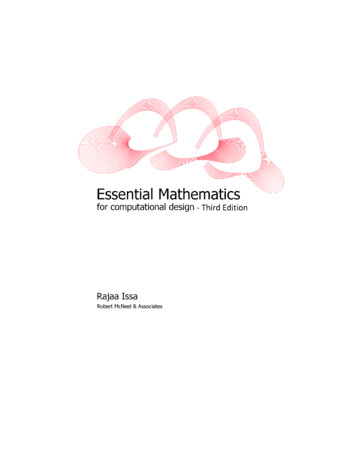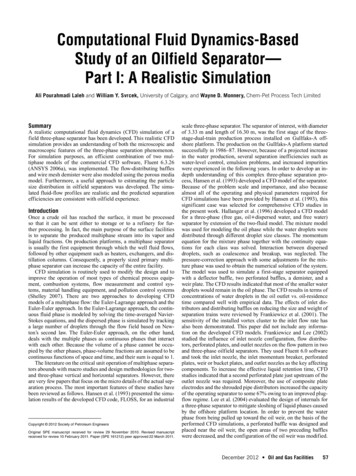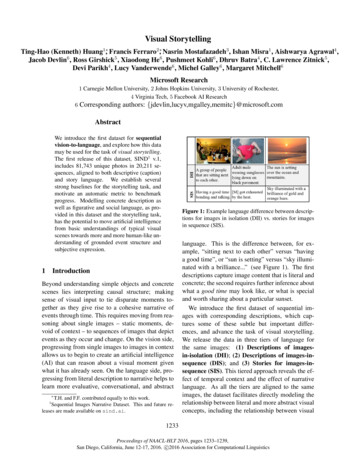
Transcription
Visual StorytellingTing-Hao (Kenneth) Huang1 , Francis Ferraro2 , Nasrin Mostafazadeh3 , Ishan Misra1 , Aishwarya Agrawal4 ,Jacob Devlin6 , Ross Girshick5 , Xiaodong He6 , Pushmeet Kohli6 , Dhruv Batra4 , C. Lawrence Zitnick5 ,Devi Parikh4 , Lucy Vanderwende6 , Michel Galley6 , Margaret Mitchell6Microsoft Research1 Carnegie Mellon University, 2 Johns Hopkins University, 3 University of Rochester,4 Virginia Tech, 5 Facebook AI Research6 Correspondingauthors: ctWe introduce the first dataset for sequentialvision-to-language, and explore how this datamay be used for the task of visual storytelling.The first release of this dataset, SIND1 v.1,includes 81,743 unique photos in 20,211 sequences, aligned to both descriptive (caption)and story language. We establish severalstrong baselines for the storytelling task, andmotivate an automatic metric to benchmarkprogress. Modelling concrete description aswell as figurative and social language, as provided in this dataset and the storytelling task,has the potential to move artificial intelligencefrom basic understandings of typical visualscenes towards more and more human-like understanding of grounded event structure andsubjective expression.1Figure 1: Example language difference between descriptions for images in isolation (DII) vs. stories for imagesin sequence (SIS).IntroductionBeyond understanding simple objects and concretescenes lies interpreting causal structure; makingsense of visual input to tie disparate moments together as they give rise to a cohesive narrative ofevents through time. This requires moving from reasoning about single images – static moments, devoid of context – to sequences of images that depictevents as they occur and change. On the vision side,progressing from single images to images in contextallows us to begin to create an artificial intelligence(AI) that can reason about a visual moment givenwhat it has already seen. On the language side, progressing from literal description to narrative helps tolearn more evaluative, conversational, and abstract T.H. and F.F. contributed equally to this work.Sequential Images Narrative Dataset. This and future releases are made available on sind.ai.1language. This is the difference between, for example, “sitting next to each other” versus “havinga good time”, or “sun is setting” versus “sky illuminated with a brilliance.” (see Figure 1). The firstdescriptions capture image content that is literal andconcrete; the second requires further inference aboutwhat a good time may look like, or what is specialand worth sharing about a particular sunset.We introduce the first dataset of sequential images with corresponding descriptions, which captures some of these subtle but important differences, and advance the task of visual storytelling.We release the data in three tiers of language forthe same images: (1) Descriptions of imagesin-isolation (DII); (2) Descriptions of images-insequence (DIS); and (3) Stories for images-insequence (SIS). This tiered approach reveals the effect of temporal context and the effect of narrativelanguage. As all the tiers are aligned to the sameimages, the dataset facilitates directly modeling therelationship between literal and more abstract visualconcepts, including the relationship between visual1233Proceedings of NAACL-HLT 2016, pages 1233–1239,San Diego, California, June 12-17, 2016. c 2016 Association for Computational Linguistics
Story 1beach (684)amusement park (525)building a house (415)party (411)birthday (399)breaking up (350)carnival (331)visit (321)market (311)outdoor activity (267)easter (259)church (243)graduation ceremony (236)office (226)father’s day (221)Table 1: The number of albums in our tiered dataset forthe 15 most frequent kinds of stories.StorytellingRe-tellingRe-tellingStory 3Story 1Story 4Preferred PhotoSequenceFlickr AlbumStory 2Story 5Descriptionfor Imagesin Isolation&in SequencesFigure 2: Dataset crowdsourcing workflow.Caption in Sequenceimagery and typical event patterns. We additionallypropose an automatic evaluation metric which is bestcorrelated with human judgments, and establish several strong baselines for the visual storytelling task.2Motivation and Related WorkWork in vision to language has exploded, with researchers examining image captioning (Lin et al.,2014; Karpathy and Fei-Fei, 2015; Vinyals et al.,2015; Xu et al., 2015; Chen et al., 2015; Younget al., 2014; Elliott and Keller, 2013), question answering (Antol et al., 2015; Ren et al., 2015; Gaoet al., 2015; Malinowski and Fritz, 2014), visualphrases (Sadeghi and Farhadi, 2011), video understanding (Ramanathan et al., 2013), and visual concepts (Krishna et al., 2016; Fang et al., 2015).Such work focuses on direct, literal description ofimage content. While this is an encouraging firststep in connecting vision and language, it is far fromthe capabilities needed by intelligent agents for naturalistic interactions. There is a significant difference, yet unexplored, between remarking that a visual scene shows “sitting in a room” – typical ofmost image captioning work – and that the same visual scene shows “bonding”. The latter descriptionis grounded in the visual signal, yet it brings to bearinformation about social relations and emotions thatcan be additionally inferred in context (Figure 1).Visually-grounded stories facilitate more evaluativeand figurative language than has previously beenseen in vision-to-language research: If a system canrecognize that colleagues look bored, it can remarkand act on this information directly.Storytelling itself is one of the oldest known human activities (Wiessner, 2014), providing a way toeducate, preserve culture, instill morals, and shareadvice; focusing AI research towards this task therefore has the potential to bring about more humanlike intelligence and understanding.1234Figure 3: Interface for the Storytelling task, which contains: 1) the photo album, and 2) the storyboard.3Dataset ConstructionExtracting Photos We begin by generating a listof “storyable” event types. We leverage the idea that“storyable” events tend to involve some form of possession, e.g., “John’s birthday party,” or “Shabnam’svisit.” Using the Flickr data release (Thomee et al.,2015), we aggregate 5-grams of photo titles and descriptions, using Stanford CoreNLP (Manning et al.,2014) to extract possessive dependency patterns. Wekeep the heads of possessive phrases if they can beclassified as an EVENT in WordNet3.0, relying onmanual winnowing to target our collection efforts.2These terms are then used to collect albums usingthe Flickr API.3 We only include albums with 10 to50 photos where all album photos are taken within a48-hour span and CC-licensed. See Table 1 for thequery terms with the most albums returned.The photos returned from this stage are then presented to crowd workers using Amazon’s Mechanical Turk to collect the corresponding stories and descriptions. The crowdsourcing workflow of developing the complete dataset is shown in Figure 2.Crowdsourcing Stories In Sequence We developa 2-stage crowdsourcing workflow to collect naturalistic stories with text aligned to images. The firststage is storytelling, where the crowd worker selectsa subset of photos from a given album to form a2We simultaneously supplemented this data-driven effort bya small hand-constructed gazetteer.3https://www.flickr.com/services/api/
DIIDISSISA man playingA black frisbeesoccer outside ofis sitting ona white housetop of a roof.with a red door.A roof topA man is standingwith a black in the grass infrisbee laying front of the houseon the top of kicking a soccerthe edge of it. ball.Why not tryA discus gotgetting it downstuck up onwith a soccerthe roof.ball?The boy isA soccer ball isthrowing aover a roof by asoccer ball by frisbee in a rainthe red door. gutter.A man is in A blue and whitethe front ofsoccer ball andthe houseblack Frisbee arethrowing aon the edge ofsoccer ball up. the roof top.Two balls and afrisbee are ontop of a roof.Two soccer ballsand a Frisbee aresitting on top ofthe roof top.Now the discus,It didn't work soUp the soccersoccer ball, andwe tried a volleyball goes.volleyball are allball.stuck on the roof.Figure 4: Example descriptions of images in isolation(DII); descriptions of images in sequence (DIS); and stories of images in sequence (SIS).photo sequence and writes a story about it (see Figure 3). The second stage is re-telling, in which theworker writes a story based on one photo sequencemanwomangenerated by workers in the first stage.standingIn both stages, all album photos are displayedholdinginwearingthe order of the time that the photos were taken,with a “storyboard” underneath. In storytelling, byclicking a photo in the album, a “story card” of thephoto appears on the storyboard. The worker is instructed to pick at least five photos, arrange the order of selected photos, and then write a sentence ora phrase on each card to form a story; this appears asa full story underneath the text aligned to each image. Additionally, this interface captures the alignments between text and photos. Workers may skipan album if it does not seem storyable (e.g., a collection of coins). Albums skipped by two workersare discarded. The interface of re-telling is similar, but it displays the two photo sequences alreadycreated in the first stage, which the worker choosesfrom to write the story. For each album, 2 workers perform storytelling (at 0.3/HIT), and 3 workers perform re-telling (at 0.25/HIT), yielding a totalof 1,907 workers. All HITs use quality controls toensure varied text at least 15 words long.Crowdsourcing Descriptions of Images In Isolation & Images In Sequence We also usecrowdsourcing to collect descriptions of imagesin-isolation (DII) and descriptions of images-insequence (DIS), for the photo sequences with stories from a majority of workers in the first task (asFigure 2). In both DII and DIS tasks, workers areasked to follow the instructions for image caption1235Data #(Txt, Img) Vocab Avg.%Abs Frazier Yngve PplSetPairs (k) Size (k) #TokBrown52.147.7 20.8 15.2% 18.5 77.2 194.0DII151.813.8 11.0 21.3% 10.3 27.4 147.0DIS5151.85.09.8 24.8% 9.223.7 146.8SIS252.918.2 10.2 22.1% 10.5 27.5 116.0Table 2: A summary of our dataset,6 following the proposed analyses of Ferraro et al. (2015), including the Frazier and Yngve measures of syntactic complexity. Thebalanced Brown corpus (Marcus et al., 1999), providedfor comparison, contains only text. Perplexity (Ppl) iscalculated against a 5-gram language model learned on ageneric 30B English words dataset scraped from the ack chatting amount trunkwent [female] seelarge gentleman goers facinggottodaysawfront enjoyssofabench [male] decided camegroup folksegg enjoying took really startedshoreline femalegreattimeTable 3: Top words ranked by normalized PMI.ing proposed in MS COCO (Lin et al., 2014) suchas describe all the important parts. In DII, we usethe MS COCO image captioning interface.4 In DIS,we use the storyboard and story cards of our storytelling interface to display a photo sequence, withMS COCO instructions adapted for sequences. Werecruit 3 workers for DII (at 0.05/HIT) and 3 workers for DIS (at 0.07/HIT).Data Post-processing We tokenize all storylets and descriptions with the CoreNLP tokenizer, and replace all people names with genericMALE / FEMALE tokens,5 and all identified namedentities with their entity type (e.g., location).The data is released as training, validation, and testfollowing an 80%/10%/10% split on the stories-insequence albums. Example language from each tieris shown in Figure 4.4Data AnalysisOur dataset includes 10,117 Flickr albums with210,819 unique photos. Each album on average has20.8 photos (σ 9.0). The average time span of eachalbum is 7.9 hours (σ 11.4). Further details of eachtier of the dataset are shown in Table 2.74https://github.com/tylin/coco-uiWe use those names occurring at least 10,000 times.https://ssa.gov/oact/babynames/names.zip6The DIS columns VocabSize-Ppl estimated based on17,425 Txt,Img pairs. Full set will be updated shortly.7We exclude words seen only once.5
We use normalized pointwise mutual informationto identify the words most closely associated witheach tier (Table 3). Top words for descriptionsin-isolation reflect an impoverished disambiguating context: References to people often lack social specificity, as people are referred to as simply“man” or “woman”. Single images often do notconvey much information about underlying eventsor actions, which leads to the abundant use of posture verbs (“standing”, “sitting”, etc.). As we turn todescriptions-in-sequence, these relatively uninformative words are much less represented. Finally, topstory-in-sequence words include more storytellingelements, such as names ([male]), temporal references (today) and words that are more dynamic andabstract (went, decided).5Automatic Evaluation MetricGiven the nature of the complex storytelling task,the best and most reliable evaluation for assessingthe quality of generated stories is human judgment.However, automatic evaluation metrics are useful toquickly benchmark progress. To better understandwhich metric could serve as a proxy for human evaluation, we compute pairwise correlation coefficientsbetween automatic metrics and human judgments on3,000 stories sampled from the SIS training set.For the human judgements, we again use crowdsourcing on MTurk, asking five judges per story torate how strongly they agreed with the statement “Ifthese were my photos, I would like using a story likethis to share my experience with my friends”.8 Wetake the average of the five judgments as the finalscore for the story. For the automatic metrics, we useMETEOR,9 smoothed-BLEU (Lin and Och, 2004),and Skip-Thoughts (Kiros et al., 2015) to computesimilarity between each story for a given
Visual Storytelling Ting-Hao (Kenneth) Huang 1, Francis Ferraro 2, Nasrin Mostafazadeh 3, Ishan Misra 1, Aishwarya Agrawal 4, Jacob Devlin 6, Ross Girshick 5, Xiaodong He6, Pushmeet Kohli 6, Dhruv Batra 4, C. Lawrence Zitnick 5, Devi Parikh 4, Lucy Vanderwende 6, Michel Galley6, Margaret Mitchell 6 Microsoft Research 1 Carnegie Mellon University, 2 Johns Hopkins University, 3 University of .
